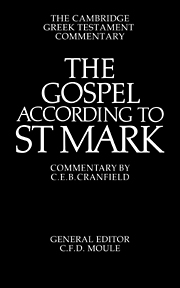Book contents
- Frontmatter
- Preface by the General Editor
- Contents
- List of Abbreviations
- Acknowledgements
- INTRODUCTION
- I AUTHORSHIP, DATE AND PLACE OF WRITING
- II THE CHARACTER OF THE GOSPEL
- III THE THEOLOGY OF THE GOSPEL
- IV TEXTUAL CRITICISM OF THE GOSPELS
- NOTES
- SUPPLEMENTARY NOTES
- REVISED ADDITIONAL SUPPLEMENTARY NOTES
- Addenda
- Index
IV - TEXTUAL CRITICISM OF THE GOSPELS
Published online by Cambridge University Press: 15 March 2010
- Frontmatter
- Preface by the General Editor
- Contents
- List of Abbreviations
- Acknowledgements
- INTRODUCTION
- I AUTHORSHIP, DATE AND PLACE OF WRITING
- II THE CHARACTER OF THE GOSPEL
- III THE THEOLOGY OF THE GOSPEL
- IV TEXTUAL CRITICISM OF THE GOSPELS
- NOTES
- SUPPLEMENTARY NOTES
- REVISED ADDITIONAL SUPPLEMENTARY NOTES
- Addenda
- Index
Summary
Since exegesis must go hand in hand with textual criticism, the student of the interpretation of the New Testament needs to have some acquaintance both with the materials for the establishment of the text of the New Testament, and with the principles governing their use for that purpose. The present note is designed as an introduction to the art of textual criticism, so far as it is concerned with the gospels. A good popular account is given by Sir Frederic Kenyon's Our Bible and the Ancient Manuscripts (4th ed., London, 1939); for more advanced study The Textual Criticism of the Mew Testament by the same author may be recommended and A. H. McNeile and C. S. C. Williams' Introduction to the New Testament (Oxford, 1953), and A. Souter's The Text and Canon of the New Testament (London, 1913, 2nd ed., revised by C. S. C. Williams, 1954). The Introduction to Westcott and Hort's edition of the New Testament in Greek (1881) and Streeter, Four Gospels, are still valuable.
MATERIALS
The materials for the establishment of the text of the Gospels consist of (a) Greek manuscripts; (b) ancient translations; and (c) quotations in the writings of early Christian authors.
(a) Manuscripts are either on papyrus or vellum, the papyri being on the whole earlier. The earliest extant manuscript of any part of the New Testament is p62, a scrap of papyrus of the first half of the second century in the John Rylands Library, Manchester, with John xviii. 31–4 on one side, and 37–8 on the other (which shows that it comes, not from a roll, but from a codex—the modern book-form).
- Type
- Chapter
- Information
- The Gospel according to St MarkAn Introduction and Commentary, pp. 22 - 30Publisher: Cambridge University PressPrint publication year: 1959



